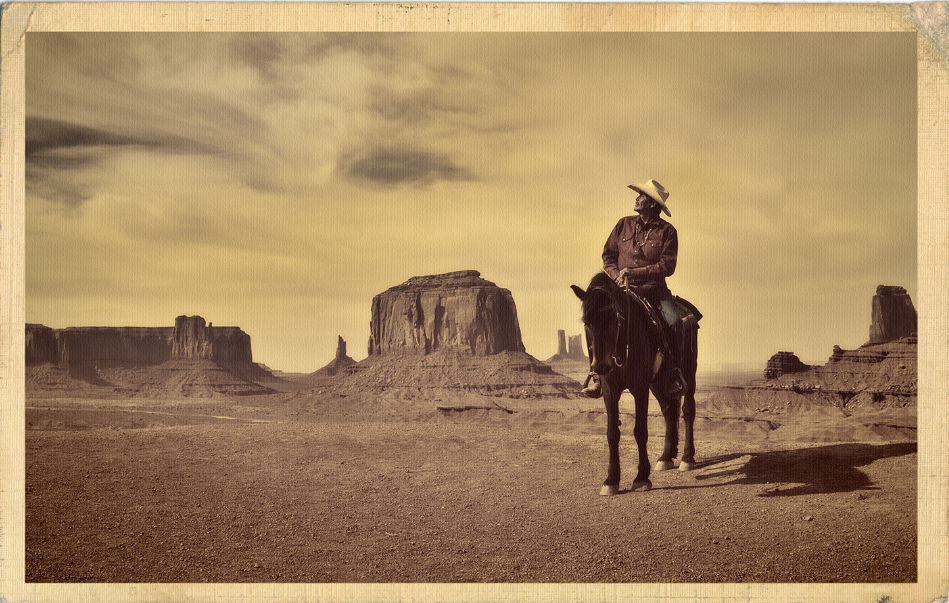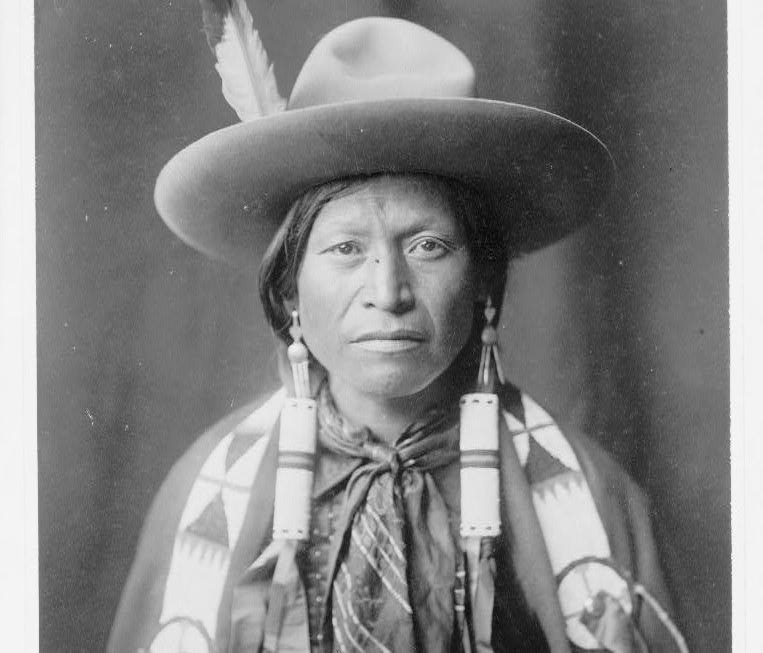
Dime-store novels and Wild West television shows helped construct the stereotypical images of the “white” cowboy and the red-skinned Indian “savages.” As the West was often portrayed as a battlefield between these two groups, it may be difficult for students to understand that so-called Indians were often also cowboys. However, this narrative of the Wild West is incomplete, and teachers can easily rectify this by teaching about the indigenous experience during this westward expansion period. Early Spanish missionaries actually trained Native Americans as cattle herders, leading many indigenous peoples to adopt ranching into their economies.
Branding cattle, riding horses, and roping skills were a natural part of the cowboy existence and often led to competitions for bragging rights as to who was the best. Native Americans were recognized for their horseback riding skills, particularly Comanche warriors, noted for their ability to shoot arrows from under a horse’s neck while galloping. The Crow people took great pride in their bronco riding skills. The rodeo was a natural extension of activities that were a fundamental part of the cowboy life. In a rodeo, Native Americans were not locked into the stereotype of primitive savagery but could establish themselves as skillful horsemen or ropers.
 Photo: Library of Congress
Photo: Library of Congress
Foster Inquiry in the Classroom
To further expand student knowledge about the Native American role in the Wild West, divide students into groups and assign each one a different ethnic cowboy group to research. Plan a panel discussion where students take on the role of various cowboys and answer questions about their careers and obstacles they overcame. Ask students to write factual paragraphs that provide important information typically left out of textbooks about Indians as cowboys.
Ask students, “Why do you think the stories of Indians as cowboys have been written out of history?” Have students research famous Indian cowboys such as the following:
- Jackson Sundown (Nez Perce), made a living breeding, raising, breaking in and selling horses; winner of the World Championship Rodeo in 1916; inducted into the American Indian Athletic Hall of Fame, the National Multicultural Western Heritage Museum and Hall of Fame, and the National Cowboy and Western Museum and Hall of Fame
- Tom Three Persons (Blood), worked as a mail carrier for the Indian Agency, a scout for the Northwest Mounted Police, and a cowboy for local ranches; winner of the first World Bucking Horse Championship at the Calgary Stampede in 1912.
- Will Rogers (Cherokee), noted writer and actor who grew up as a cowboy
- Teesquantee Woolman (Cherokee), three times National Finals Rodeo (NFR) Team Roping World Champion
- Tom Reeves (Sioux), team captain for U.S. Olympic rodeo team in 2002
- Robert Yellowtail (Crow), cattle rancher, lawyer; helped write the 1920 Crow Act ensuring Crow lands could never be taken without tribal consent; his work on Native rights directly led to American Indians being given the right to vote.
- Dean C. Jackson (Navajo), one of the founding organizers of the All-Indian Rodeo Cowboys Association and the Indian Nationals Finals Rodeo.

Project-based Learning
There are many pathways to teach about the Native American experience during the western expansion period in American history. These research-based suggestions tell a part of a bigger narrative about indigenous peoples as a whole. Any of the suggestions below can be used as a way for students to reflect on their learning, a project-based learning activity where students work individually or in groups, or a research paper.
- Have students read passages from the Singing Sioux Cowboy Reader, by Ann Clark. The book was written in 1947 as part of a series from the US Indian Service. It has verses written in Teton Lakota (Sioux) on one page, and the opposite page is in English. Ask students, “Did all Indian tribes have a written language? What would cowboys need to write or read?”
- The outdoor job of being a cowboy required durable clothing that protected against sun, wind, dust, rain, thorny cacti, and shrubs. Ask students to research the many purposes of bandanas, spurs, hats, boots, chaps, cuffs, leather gloves, and slickers for the cowboy. Ask students, “Which piece of clothing do you think the drag riders (bringing up the rear of the herd on a cattle drive) found the most helpful? Would cowboy Indians dress in their Native dress or in cowboy dress?”
- The cowboy is considered a symbol of the West, a kind of folk hero. Have students identify characteristics of a folk hero. Ask students, “How is a Native American a folk hero?”
Information on Native American cowboys is documented in historical records and children’s literature. Some books to use are
- Tom Three Persons: Legend of an Indian Cowboy;
- Jackson Sundown: Native American Bronco Buster;
- When Indians Became Cowboys: Native Peoples and Cattle Ranching in the American West;
- The True West: Real Stories about Black Cowboys, Women Sharpshooters, Native American Rodeo Stars, Pioneering Vaqueros, and the Unsung Explorers, Builders, and Heroes Who Shaped the American West; and
- Grandpa Was a Cowboy and an Indian, and Other Stories.
Cattle ranching is a story that is usually told and understood in one color—white. Competition for control and use of the land in the West restricted Native holdings. Cattle ranching was a way to build a local economy and became a part of the culture and heritage of many Native tribes. Like cowboys, American Indians are often envisioned through a nostalgic nineteenth-century lens. Both groups are expected to look a certain way or live a particular way according to standards set by movies, books, or paintings. However, teaching only one side of this narrative does a disservice to the rich history of these indigenous peoples. With a common sense of place and tradition, a love for the outdoors, and skills for working with cattle and horses, cowboys were Indians and Indians were cowboys.
Seeking more professional learning resources?
See what our professional learning department can do for your teaching
Kay Gandy is a retired professor of seventeen years and a retired elementary teacher of twenty-seven years. Her goal is to work with teachers in countries around the world and watch movies in foreign theaters. Her books Mapping Is Elementary, My Dear and 50 Ways to Teach Social Studies (June 2021) provide practical lesson ideas for elementary teachers.

I am Tom Reeves who is referenced. I would love to visit any classes either in person or via Zoom.
Hi Tom, it’s a pleasure to meet you! We loved including you in this article and it’s a popular one! We are not a school but rather a publisher of educational materials for K-12 schools across the US and Canada, but hope you made the connections you’re looking for. If you are interested in submitting a blog about education for K-12 students, please fill out the form on our blog submission page with a topic you’re interested in covering! Here is the link to our author page: https://go.socialstudies.com/blog-authors